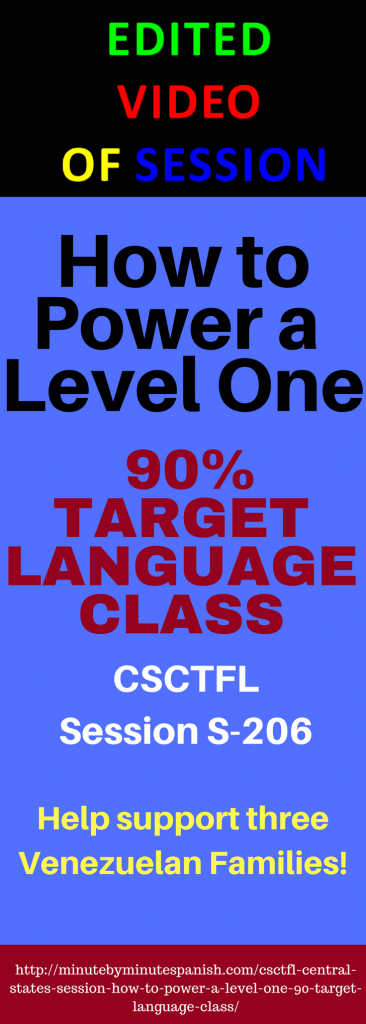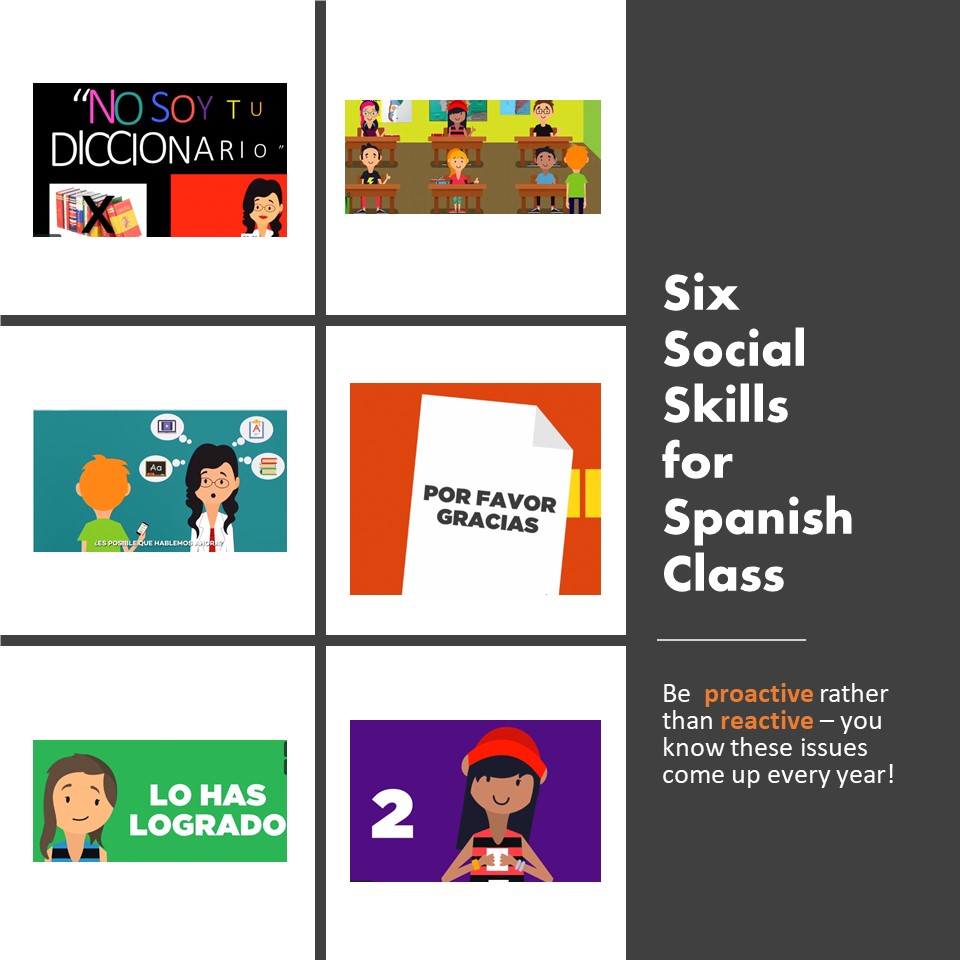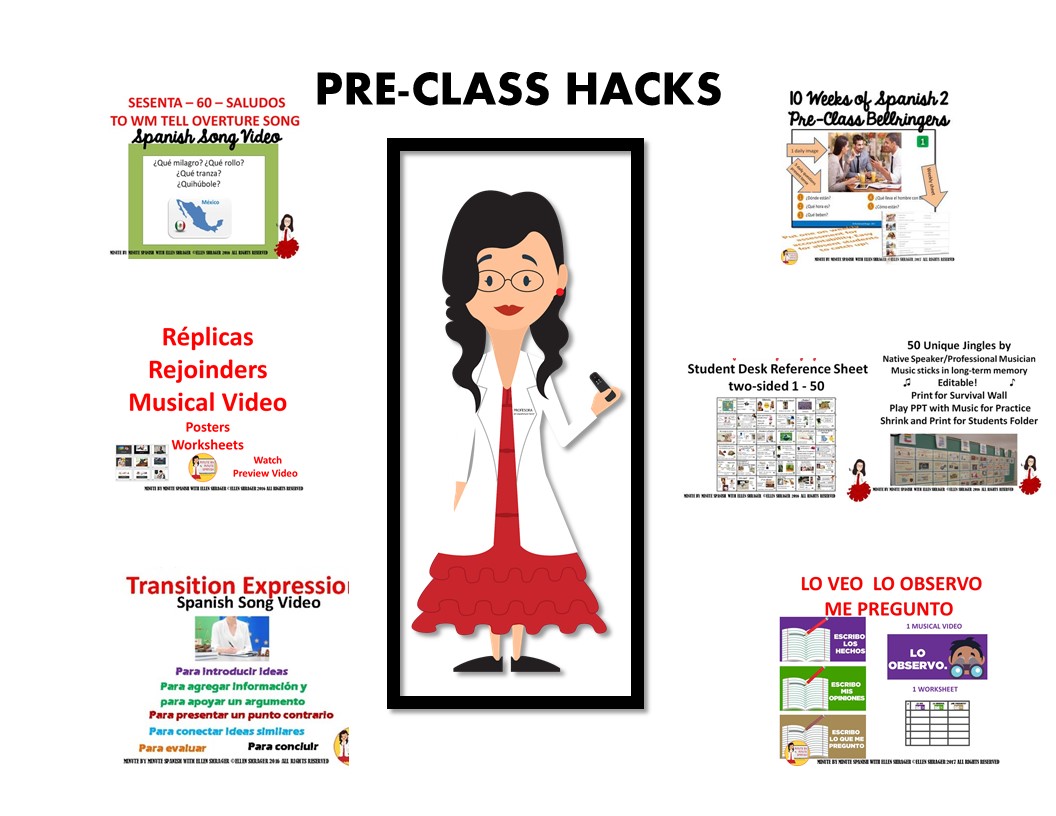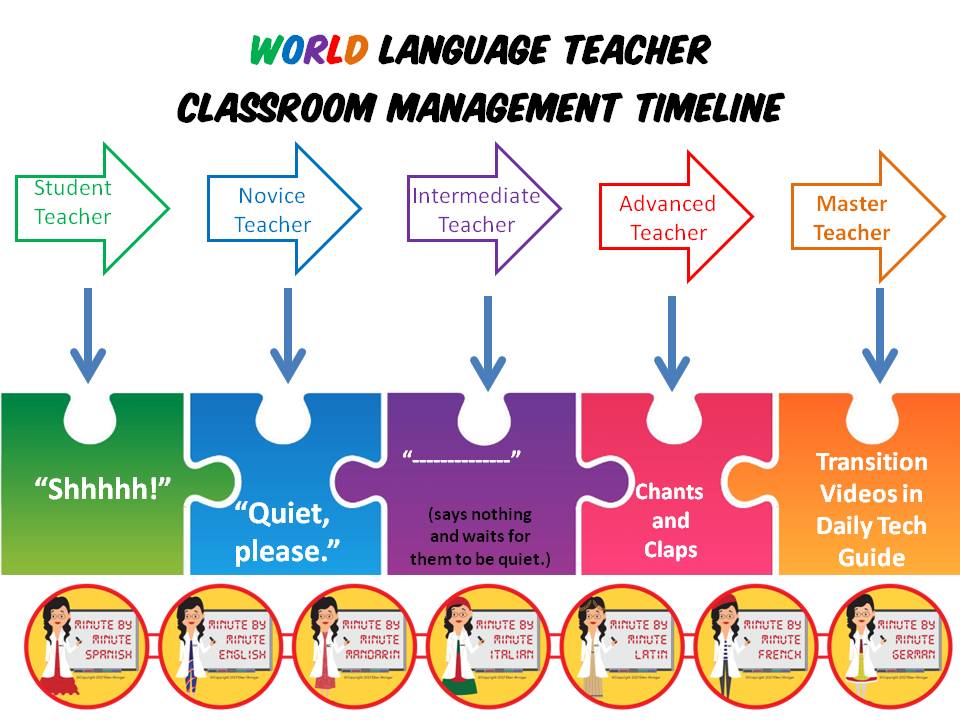
Stay on Task and in the target language with transition videos.
Spanish Lessons

Stay on Task and in the target language with transition videos.
Handout for central states 2018 Friday S-206



When I started teaching in the 80’s, teachers were expected to be caring adults providing boundaries and feedback about appropriate behavior.
In 2020, when responding to a student’s inappropriate behavior, I am contacted by parents about their concern that I don’t like their child. I fear that students are learning their social skills from social media; many are not making the correct leap from talking to Alexa to talking to their teacher.
After thirty plus years of teaching the same age group, I can predict certain topics that come up every year and rather than correct a student for being inappropriate, I proactively give direct instruction on social skills using catchy musical videos to everyone. Thus, when a student is interrupts, or treats me like a walking dictionary, the rest of the class breaks out into song and the correction is considered impersonal rather that a personal correction.
We, my Venezuelan friends and I, have created six musical videos sung in Spanish to demonstrate these skills. See the video below about the Venezuelans who make the songs and videos and how all net proceeds go to them as this is my charity work.
It includes offering to escort the new student to his or her next class, offering to eat lunch together, sharing recent classwork, and welcoming them to the class.
Many students write emails to teachers as if they were texting a friend. This social skill video reminds students to identify themselves, address the teacher by name and use querido, atentamente, por favor, gracias. The video reminds them that their future bosses may not know how capable they are because their poor manners.
This will save you from middle school teacher burnout! I share rooms and am rushing into set up my laptop and complete a variety of housekeeping tasks and it can take my last ounce of patience when a student just starts talking to me in a long-winded story. Now they know to first ask if now is a good time and if it isn’t I always circle back to them. This has made for much more pleasant relationships and a smooth start to class. It may very well help them to keep future jobs. Parents tell me they love it when I explain it to them at Open House and they also use it with me!
The best way to ensure that students get along in a class is to use random grouping cards and explain to them the importance of learning how to work with everyone. All of the directions are included along with the video. Be the adult in the class and set the expectation that they must work with anyone for a week at a time and they will. Let’s fight the growing tide of selected social media narrowing the variety of exposure that students have to different kinds of people. By the end of the year, substitute teachers and students will comment on how well the class gets along.
We must give our students direct instruction on how to congratulate one another in the target language.
Use this musical video, and ‘en hora buena’ and ‘felicitaciones’ will roll off their tongues at appropriate times.
Let’s further examine this issue of asking Spanish teachers to be a walking dictionary.
Students in our classes are accustomed to asking Alexa questions at home and getting immediate answers. When I first started teaching, we spent a couple of days using paper dictionaries and teaching them how to look up infinitives and other basic skills. Now we train them to use Word Reference while they may still very well be ‘Google Translating’ their homework.
I even had a parent send me a google translated e-mail – and she has never studied Spanish. She thought I would be so impressed! But I digress.
We train our students to ask three before me or use three before me or write their name on the board with the word they need help with in the hopes a classmate will help out.
But the best solution is to teach them the song “No soy tu diccionario” and when they forget and ask you how to say something the rest of the class breaks out into the song.
It works!
Every year students want to learn how to insult one another in Spanish. They will ask me how to say “stupid” in Spanish so that they can insult one another.
You do you with your teaching voice, but my response, said with the sweetest, most sincere drippy concern of a grandmother, “oh honey, I see why you feel that way about yourself but it would break my heart to have you talk about yourself that way, no I just can’t add to your negative self-talk – you are just too good!” This puts the kid in checkmate – can’t admit he/she wants to use it for others and the whole class is laughing about my thinking he/she wants to call himself/herself stupid when clearly the intention is to insult someone else.
All net proceeds help three Venezuelan families – meet them in this video as they open three boxes I sent to them.
If you want to read more about class structure and transition videos, read my blog here.
If your school won’t provide you with these tools, you may consider this:





As we head back to our classrooms, it is time to decide the best way to start our language class.
It really depends on our schedule because the year we teach the same class three times a day in the same room without having to share it with another teacher is very different from the year we are moving room to room or switching subjects/languages that we teach.
With the former, I play the “day of the week” song so that as students walk in they are switching to their target language and commenting on their reaction to it being Friday or Tuesday using the words in the song to express themselves.
I have it and my lesson in a daily slide show and all songs play as soon as I click to the next slide. I use a remote presentation device for this – I can be out in the hall doing this and the slide will change!

When I am ready to start class, I use my remote clicker to play the count down song and students enjoy counting down as everyone must be seated before it ends.
I click into the class greetings slides with the daily calendar video and taking attendance routine video. And we are off! This routine works so well that teachers in six other languages have adapted them and are also available – see below.
But when I float or am switching gears from teaching a different subject and need a few extra minutes, then my students know to take out their weekly “bellringer” sheets, or open to them on their Google Drives.
I have six kinds of “bellringer” and they all involve music. Students are listening to a native speaker while I take care of administrative tasks.
_1_Instructional Video – Lo veo – Paper from ellen shrager on Vimeo.
Spanish Two Pre-Class Bellringers with level1 Questions 10 weeks low prep from ellen shrager on Vimeo.
Students feel safe when they know what to do but are curious as to which picture will be used today. It is the right blend of routine and innovation. Give yourself a bit of grace starting each class with one of these and not stress about taking care of your administrative tasks while the students are engaged.
Spanish Rejoinders Replicas Musical Video from ellen shrager on Vimeo.
Spanish AP Upper Level Writing Transition Words from ellen shrager on Vimeo.
4-saludos-y-hola2 from ellen shrager on Vimeo.
Students feel safe when they know what to do but are curious as to which picture will be used today. It is the right blend of routine and innovation. Give yourself a bit of grace starting each class with one of these and not stress about taking care of your administrative tasks while the students are engaged.
These videos are available in other languages.
Click here for Italian videos.
Click here for Mandarin videos



I wish taxpayers who begrudge our summer break could see all of the June posts popping up on Facebook as World Language Teachers research and plan for the new school year.
Many posts ask how to make a level one class 100% comprehensible so that both teachers and students can stay in the target language.
I’ve always addressed this in pieces but it’s time to put it all three steps together as teachers recharge and envision the way they want their classes to run.
Incorporate these three steps and you will have your 90% Target Language class . . . and superior classroom management.
Create a slide for each activity and use a remote presentation device or remote mouse so you can click through the slides from any spot in the room,  say near the students who go off task most frequently. Click here to download the first day and see videos of the first week to give you an idea.
say near the students who go off task most frequently. Click here to download the first day and see videos of the first week to give you an idea.
My book describes it in more detail.
Other bundles are also Spanish Lessons here..
2. Use transition videos before each slide to keep the students on task and in the target language.
See them here. Spanish available here.
3. Use direct instruction to teach students 50 survival phrases set to music. Include the matching posters and desk reference sheet – focusing on the student – to – student slides so that they know how to talk to one another in the target language.
See them here. Available here.



Congratulations. Regardless of the actual number of years teaching, you are an advanced teacher if you use chants and claps for transitions to manage your classroom.
Are you ready to go to the next level?
Here are the three steps to follow to move from being an advanced classroom manager to a master classroom manager.
Three Steps:
1. Make a slide for each activity in today’s lesson — make it appealing and useful. (for more ideas, read The World Language Daily Tech Guide)
2. Insert one of my brief 50+ transition videos before the slide and train your students to watch the video in Spanish. Soon they are imitating the voice over or else singing the song. Do this every day and when you are observed by your administrators they will note your seamless transitions. You will notice that the students stay in the target language and that the expressions in the videos just fall from your students’ mouths appropriately in other scenarios! Even my level one students are spontaneously contributing these expressions at appropriate times!
3. Buy a remote presentation device or wireless mouse and click to the next slide from any part of the room so you can stand close to students who struggle to behave.
Here are the basic 21 videos for transitions:
More Transitions:
Click here for another thirty videos!


| Cookie | Duration | Description |
|---|---|---|
| cookielawinfo-checkbox-analytics | 11 months | This cookie is set by GDPR Cookie Consent plugin. The cookie is used to store the user consent for the cookies in the category "Analytics". |
| cookielawinfo-checkbox-functional | 11 months | The cookie is set by GDPR cookie consent to record the user consent for the cookies in the category "Functional". |
| cookielawinfo-checkbox-necessary | 11 months | This cookie is set by GDPR Cookie Consent plugin. The cookies is used to store the user consent for the cookies in the category "Necessary". |
| cookielawinfo-checkbox-others | 11 months | This cookie is set by GDPR Cookie Consent plugin. The cookie is used to store the user consent for the cookies in the category "Other. |
| cookielawinfo-checkbox-performance | 11 months | This cookie is set by GDPR Cookie Consent plugin. The cookie is used to store the user consent for the cookies in the category "Performance". |
| viewed_cookie_policy | 11 months | The cookie is set by the GDPR Cookie Consent plugin and is used to store whether or not user has consented to the use of cookies. It does not store any personal data. |